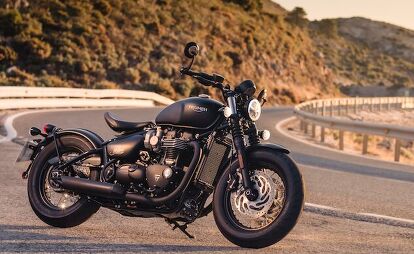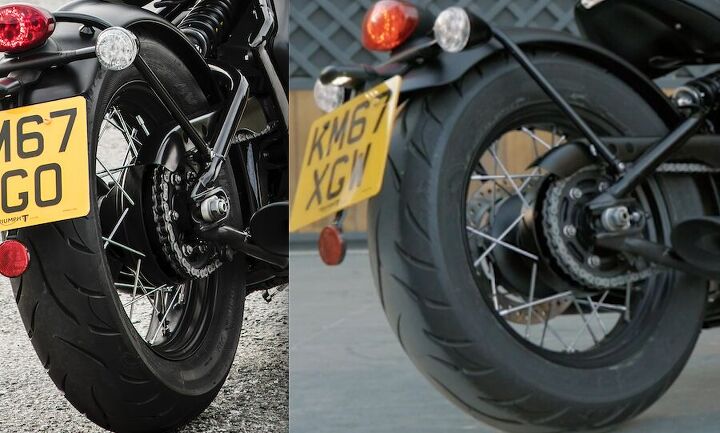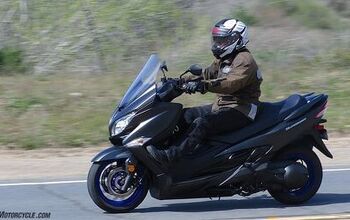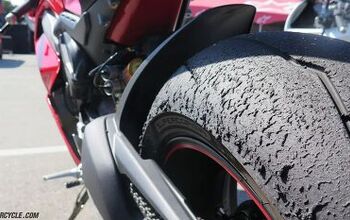Top 5 Details on Triumph's 2018 Bonneville Bobber Black
Anything retro seems to be all the rage lately, and I’m okay with that because in a way, it pulls on our heartstrings. Technology is improving so quickly that it’s hard to keep up with all the latest and greatest. As soon as you think you have the best, something better comes along. But one thing that stays constant is the past, and this is where nostalgia comes into play.
Nostalgia is more than just a feeling or reaction to the past, it’s a warm and fuzzy, powerful emotion that we sense whenever we delve into fond memories from our yesteryears. It’s an homage to the way things used to be, and motorcycle manufacturers are taking advantage of it – as they should. Just about all the big companies have retro inspired bikes now – from Yamaha’s XSR700 and XSR900 and Kawi’s RS lines to Triumph’s Bonnevilles and Bobbers.
These bikes have all the modern tech features that anyone would expect from the latest motorcycles, but styling cues reminiscent of the past. And I must say, designers are doing their homework when it comes to the nitty-gritty particulars that can easily go unnoticed and overlooked. The devil is in the details, though, and below are five things someone put a lot of thought into for which they may not be getting the credit they deserve.
1. Hard-tail Look
Today, it’s difficult to conceive riding a hard-tailed motorcycle (for most, anyhow). I happen to own two and it’s really not as bad as it sounds, but that’s beside the point. I will say though, hard-tailed bikes do look great, but why would anyone put themselves through the rattle and harsh ride if rear suspension were available? Well, Harley-Davidson answered that question in 1984 with the release of the Softail.
Fast forward 30 years and manufacturers like Triumph are giving their bikes that rigid look while offering a comfortable and forgiving ride. The Bonneville Bobber Black’s straight backbone paired with the tractor-style solo-seat looks right out of the post-WWII era while providing 21st century comfort and performance. From afar, the Black wouldn’t look out of place parked next to an old-school chopper, but up close the level of refinement is on par with any 2018 offering.
2. Carburetor-Styled Throttle Bodies and Air Filters
Without going into much detail, carburetors and throttle bodies achieve the same goal of providing an engine with an air/fuel mixture for combustion. The two technologies go about it in different ways, but the end result is the same. Due to greater efficiency and emissions laws, street bikes for the most part are all fuel injected these days, and the Bobber Black is no different.
With the old-school image and style of the Bobber, Triumph designers engineered the Black’s throttle bodies to look like carburetors because well, older bikes were carbureted. It wasn’t until 1980 when motorcycles were first equipped with fuel injection, and the vast majority remained carbureted until the turn of the century. And they didn’t stop there, either – attached to the throttle bodies are what appear to be separate twin air filters but the actual air intake happens through the dual-chamber airbox directly under the floating seat. There’s no real advantage in the performance aspect of the design, but Triumph definitely scores creative points in the looks department.
3. Rear Wheel Drum-Brake Style Hub
It’s not a big standout feature, but possibly the most overlooked or unnoticed design nuance on the Bobber is its rear wheel hub. Triumph engineers designed it to look like a more classic, drum brake hub, but obviously the Bobber sports a 255mm disc and a Nissin caliper with ABS to boot. But for a potential owner of the new Bobber, this inconspicuous design might remind them of the good ol’ days when brake shoes handled the stopping, and I’m not talking about the Fred Flintstone method.
4. Exposed Battery Box and Stainless Steel Strap
Another subtle detail is the exposed battery box with its stainless steel strap. Many designs these days try to cover up or hide a motorcycle’s operating systems by tucking them away behind panels and fairings, which can be nice and easy on the eyes, until you have to remove everything to work on it.
Triumph stays true to the Bobber’s custom ethos of supreme minimalism by leaving important components exposed and accessible. For extra style points, you could swap that stainless strap for a leather one.
5. Bar-End Mirrors
Last but not least, and again playing to the uncluttered and minimalist spirit of stripped-down café-racer-style British bikes of the 1960s and ‘70s are the Bobber’s bar-end mirrors. I’ve been a longtime fan of bar-end mirrors, not just for their minimalist look, but also for their improved performance over more traditional mirrors. Not only do they often give the rider a better view of what’s going on behind, instead of looking at your shoulders and elbows, but they vibrate less too. Form and function – check and check. Who says you can’t have your cake and eat it too?
More by Brent Jaswinski







































Comments
Join the conversation
The bike looks great, and I'm not a cruiser fan generally.
Regarding nostalgia, your words are worth linking to "emotion recollected in tranquility".
People forget that Triumph is the older company so sometimes it's not Triumph copying HD but vice versa. Bike looks nice but without a place to perch a babe it's not very useful